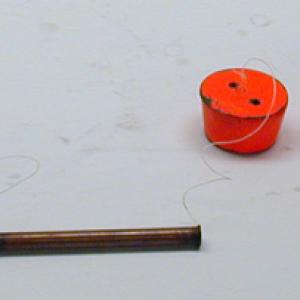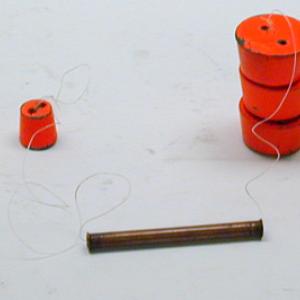College of Liberal Arts & Sciences
1D50.20 - Whirligig/Twirling Weights
The two masses on a string when once started whirling is most safely stopped by pulling back down on the large weight.
- Paul Hewitt, "Answer to January 2019 Figuring Physics", TPT, Vol. 57, #2, Feb. 2019, p. 116.
- Richard D. Kaufman, "Angular Acceleration Without Torque?", TPT, Vol. 50, #1, Jan. 2012, p. 35.
- Paul Hewitt, "Figuring Physics", TPT, Vol. 49, #6, Sept. 2011, p. 326.
- Jeff Whittaker, "Demonstrating Circular Motion With a Model Satellite/ Earth System", TPT, Vol. 46, #4, Apr. 2008, p. 237.
- James L. Hunt, "Five Quantitative Physics Experiments (Almost) Without Special Apparatus", TPT, Vol. 43, #7, Oct. 2005, p. 412.
- Robert Johns, "Acceleration Without Force?", TPT, Vol. 41, #3, Mar. 2003, p. 156.
- Martin Gardner, "The Twirled Ring", TPT, Vol. 40, #1, Jan. 2002, p. 51.
- Desmond N. Penny, "A Nonuniform Circular - Motion Experiment", TPT, Vol. 38, #8, Nov. 2000, p. 483.
- John L. Makous, "Variations of a Circular-Motion Lab", TPT, Vol. 38, #6, Sept. 2000, p. 354.
- Bill Jameson, "Additions to a Circular- Motion Lab", TPT, Vol. 37, #9, Dec. 1999, p. 545.
- Charles Henderson, "Measuring the Forces Required for Circular Motion", TPT, Vol. 36, #2, Feb. 1998, p. 118.
- Paul G. Hewitt, "Typo", TPT, Vol. 32, #5, May 1994, p. 262.
- Paul Hewitt, "Figuring Physics", TPT, Vol. 32, #3, Mar. 1994, p. 186.
- Kaye M. Elsner, "Visualizing Centripetal Force", TPT, Vol. 32, #3, Mar. 1994, p. 176.
- Juan Lin, "A Demonstration of Kepler's Third Law", TPT, Vol. 31, #2, Feb. 1993, p. 122.
- G.J. Aubrecht, A.P. French, M. Iona, and D.W. Welch, "The Radian - That Troublesome Unit", TPT, Vol. 31, #2, Feb. 1993, p. 84.
- "How Can Work Be Done In This Case?", TPT, Vol. 15, #5, May 1977, p. 309.
- Frank S. Crawford, "Explaining the Orbital Velocity of an Earth Satellite," AJP, Vol. 55, #3, Mar. 1987, p. 275.
- Francis Wunderlich, "Determination of 'g' through Circular Motion", AJP, Vol. 34, #12, Dec. 1966, p. 1199.
- Mm-1, 2, Ms-5: Freier and Anderson, A Demonstration Handbook for Physics.
- M-198: "Three Neons & Ball on a String", DICK and RAE Physics Demo Notebook.
- M-742: "Ball on String-Coin in Balloon", DICK and RAE Physics Demo Notebook.
- Tik Liem, "A Measure of Centripetal Force", Investigation to Science Inquiry, 14.18, 380.
- David Kutliroff, "42, Illustrate Centripetal Force with a Mass on a String", 101 Classroom Demonstrations and Experiments For Physics Teachers, p. 95.
- "16. In and Out", Janice VanCleave's 201 Awesome, Magical, Bizarre, & Incredible Experiments.
- "32. In and Out", Janice VanCleave's Astronomy for Every Kid: 101 Easy Experiments That Really Work, p. 70.
- "Concepts in Motion", "E12: Centripetal Force", The Project Physics Course - Teachers Resource Book, p. 84.
- Robert Ehrlich, "Whirligig with a Hanging Weight", Turning the World Inside Out, p. 72 - 73.
- Charels Windsor, "Measuring the Acceleration of Gravity with a Rotating Rubber Stopper", Ames High School Notes.
- "Lift the Pot", The Usborne Book of Experiments.
- Borislaw Bilash II, “Centripetal Force and Acceleration“, A Demo A Day – A Year of Physical Science Demonstrations, p. 216.
Disclaimer: These demonstrations are provided only for illustrative use by persons affiliated with The University of Iowa and only under the direction of a trained instructor or physicist. The University of Iowa is not responsible for demonstrations performed by those using their own equipment or who choose to use this reference material for their own purpose. The demonstrations included here are within the public domain and can be found in materials contained in libraries, bookstores, and through electronic sources. Performing all or any portion of any of these demonstrations, with or without revisions not depicted here entails inherent risks. These risks include, without limitation, bodily injury (and possibly death), including risks to health that may be temporary or permanent and that may exacerbate a pre-existing medical condition; and property loss or damage. Anyone performing any part of these demonstrations, even with revisions, knowingly and voluntarily assumes all risks associated with them.

